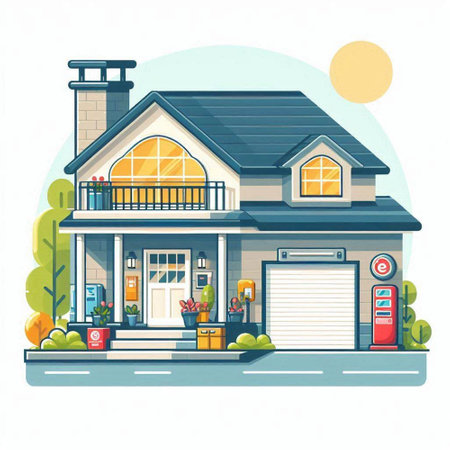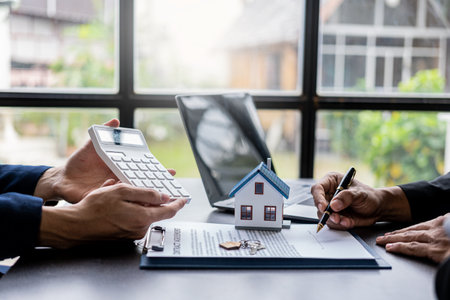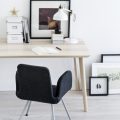1. Choosing the Right Space
Before you start decorating or buying furniture, the first step in creating a stylish and functional home office is picking the right spot in your home. The space you choose can make a big difference in your productivity and comfort. Here are some simple tips to help you find the ideal location for your home office.
Natural Light Matters
Look for a room or corner that gets plenty of natural light. A space near a window not only boosts your mood but also helps reduce eye strain during long work hours. If natural light is limited, make sure theres enough room for good artificial lighting.
Watch Out for Noise
Try to pick an area away from high-traffic zones like the kitchen or living room. Noise from TVs, conversations, or household chores can be distracting. If quiet spaces are limited, consider using noise-canceling headphones or adding soundproofing features like rugs and curtains.
Think About Foot Traffic
You’ll want a space that allows you to focus without constant interruptions. Avoid areas close to the front door or kids’ play areas if possible. If space is tight, you can still carve out a quiet nook with a room divider or bookshelf.
Quick Comparison Table
| Factor | Ideal | Avoid |
|---|---|---|
| Natural Light | Near windows with daylight | Dark corners or basements with no windows |
| Noise Levels | Rooms with doors that close tightly | Next to kitchens, playrooms, or TV rooms |
| Foot Traffic | Low-traffic areas like guest rooms or upstairs nooks | Main hallways or near entryways |
Pro Tip:
If youre short on space, even a large closet (also known as a “cloffice”) can be transformed into a cozy and efficient home office with proper lighting and ventilation.
Designing for Style and Comfort
Creating a home office thats both stylish and comfortable starts with thoughtful design choices. Whether youre converting a guest room, a corner of the living room, or even a closet nook, selecting the right color palette, furniture style, and layout can make all the difference in how productive and relaxed you feel in your workspace.
Choosing the Right Color Palette
Color has a big impact on mood and energy. For a home office, youll want colors that inspire focus while also making the space feel inviting. Here are some popular choices:
| Color | Effect | Best For |
|---|---|---|
| Soft Blues | Calming and helps concentration | Creative work, writing, customer service |
| Warm Neutrals (beige, taupe) | Cozy and professional | Client meetings, video calls |
| Earthy Greens | Refreshing and reduces eye strain | Long working hours, tech jobs |
| Pops of Yellow or Orange | Boosts energy and creativity | Brainstorming zones or accent walls |
Selecting Furniture That Fits Your Style
Your desk and chair are the most important pieces in your home office. Choose furniture that not only matches your design taste but also supports your comfort during long work sessions.
Popular Home Office Furniture Styles:
| Style | Description | Recommended For |
|---|---|---|
| Modern Minimalist | Sleek lines, neutral colors, clutter-free look | Small spaces, tech-focused work |
| Mid-Century Modern | Wood tones, retro shapes, timeless appeal | Creative professionals, writers, designers |
| Traditional Classic | Rich wood finishes, elegant details | Lawyers, consultants, formal settings |
| Industrial Chic | Metal frames, exposed materials, urban vibe | Younger professionals, artists, startups |
Laying Out Your Home Office Space Effectively
A well-planned layout helps reduce distractions and improves your workflow. Before arranging furniture, consider how natural light enters the room, where outlets are located, and how much storage youll need.
Tips for an Efficient Layout:
- Desk Placement: Position your desk near a window if possible to benefit from natural light—great for boosting mood and reducing eye strain.
- Zoning: Divide your space into zones: one for working (desk), one for thinking or reading (comfortable chair), and one for organizing (shelves or cabinet).
- Cable Management: Use cord organizers or under-desk trays to keep wires tidy and out of sight.
- Avoid Clutter: Keep only what you need within arm’s reach. Store extra supplies in bins or drawers to maintain a clean look.
Your home office should reflect your personal taste while supporting your daily tasks. With the right balance of color, style, and layout planning, any room can become a productive space you’ll actually enjoy spending time in.

3. Maximizing Functionality in Small Spaces
Not everyone has the luxury of a spare room for a dedicated home office. But with a little creativity, even the smallest nook or shared space can become a productive and stylish workstation. Whether you’re working out of a corner in your bedroom, a closet, or part of the living room, here are practical ways to make the most of limited square footage without compromising on design.
Smart Furniture Choices
When space is tight, every piece of furniture needs to pull double duty. Look for compact desks, wall-mounted tables, and fold-out options that can be tucked away when not in use. Consider investing in pieces that offer built-in storage like drawers or shelves.
| Furniture Type | Functionality | Style Tip |
|---|---|---|
| Wall-mounted Desk | Saves floor space; folds up when not in use | Choose one with a sleek finish to match your décor |
| Ladder Shelf Desk | Combines desk and shelving in one vertical unit | Add decorative baskets for hidden storage |
| Storage Ottoman | Acts as seating and hidden file storage | Use fabric that complements your color palette |
Vertical Storage Solutions
Don’t forget about your walls! Vertical space is often underused but can be a game-changer in small home offices. Floating shelves, pegboards, and hanging organizers help keep your desk clutter-free while adding visual interest.
Ideas for Vertical Storage:
- Pegboards: Hang tools, supplies, or even small plants for a creative twist.
- Wall Grids: Clip notes, inspiration photos, or calendars to keep things organized and stylish.
- Cubby Shelves: Use labeled bins to store documents and accessories neatly.
Create Zones in Multi-Use Rooms
If you’re sharing space with another function—like a guest room or living area—use rugs, lighting, or furniture placement to define your workspace. This helps mentally separate “work mode” from “home mode,” which is essential for productivity.
Tips for Creating Work Zones:
- Area Rugs: Visually separate your office area from the rest of the room.
- Task Lighting: A dedicated desk lamp signals work time and improves focus.
- Screens or Room Dividers: Add privacy and minimize distractions during meetings.
Clever Storage Hacks
You don’t need bulky filing cabinets to stay organized. Think outside the box with under-desk storage carts, wall-mounted magazine holders, or even repurposed kitchen organizers. The key is to keep essentials within reach without overcrowding your workspace.
Quick Storage Solutions:
- Trolley Carts: Roll out only when needed; great for supplies or printer storage.
- Mason Jars & Cups: Store pens, scissors, and other small items stylishly on shelves.
- Shoe Organizers: Hang on doors to store cables, notebooks, or chargers discreetly.
A functional home office doesn’t require a lot of space—just smart planning and thoughtful design. With these tips, even the tiniest corner can become a place where productivity meets personal style.
4. Incorporating Smart Tech and Ergonomics
Creating a stylish and functional home office isn’t just about good looks—it’s also about making sure your space supports productivity and comfort. Adding smart technology and ergonomic furniture can take your home office to the next level. Heres how to blend tech and ergonomics for an efficient, healthy workspace.
Must-Have Smart Tech Tools
Smart tech can simplify your workday, boost efficiency, and help maintain a clutter-free environment. Here are a few essentials worth considering:
| Smart Tech Tool | Description |
|---|---|
| Smart Lighting | Voice-controlled or app-enabled lighting that adjusts brightness and color temperature to reduce eye strain. |
| Wireless Charging Station | Keeps your desk tidy while powering up your phone and other devices without messy cords. |
| Noise-Canceling Headphones | Helps you stay focused by blocking out background noise, perfect for shared spaces or apartments. |
| Smart Assistant (e.g., Amazon Echo, Google Nest) | Manage reminders, meetings, and even control other smart devices with simple voice commands. |
| Cable Management System | A simple yet essential item to keep cords organized and out of sight for a cleaner look. |
The Essentials of Ergonomics
Sitting at your desk all day can take a toll on your body if you’re not set up properly. Investing in ergonomic furniture and accessories can prevent aches and promote better posture.
| Ergonomic Item | Why It Matters |
|---|---|
| Adjustable Office Chair | A chair with lumbar support, adjustable height, and tilt ensures proper alignment for long hours of sitting. |
| Sit-Stand Desk | The flexibility to switch between sitting and standing helps reduce fatigue and improve circulation. |
| Laptop Stand or Monitor Riser | Keeps your screen at eye level to avoid neck strain. |
| External Keyboard & Mouse | Makes typing more comfortable when using a laptop stand or riser. |
| Footrest | Aids in maintaining proper leg positioning, especially if your feet don’t rest flat on the floor. |
Create a Comfortable Work Environment
You don’t need to invest in every gadget at once—start with the basics that fit your needs and budget. Think about your daily routine: Do you spend a lot of time on calls? Then noise-canceling headphones might be key. Sitting all day? A sit-stand desk can make a big difference. Blending smart tools with ergonomic design will help you stay productive while taking care of your health.
5. Adding Personal Touches
Turning a room into a home office isn’t just about desks and chairs—it’s also about making the space feel like your own. Adding personal touches can help create a work environment that is both inspiring and comfortable, while still looking polished and professional.
Why Personalization Matters
Your home office should reflect who you are. A personalized space can boost creativity, reduce stress, and make working from home more enjoyable. It’s about finding the right balance between self-expression and a clean, clutter-free work zone.
Ideas to Make It Yours
Here are some simple yet effective ways to personalize your home office without compromising on professionalism:
| Item | Suggestions |
|---|---|
| Photos | Choose 1–2 framed photos of family, friends, or memorable places. Keep them tasteful and minimal to avoid visual distraction. |
| Art | Hang artwork that reflects your personality or inspires you—abstract prints, motivational quotes, or even DIY pieces work great. |
| Plants | Add greenery like succulents, snake plants, or peace lilies. They purify the air and add a calming vibe to the room. |
| Books | Select a few favorite titles or industry-related books to display on shelves. They show professionalism while adding character. |
Keep It Balanced
While it’s important to make the space yours, be mindful not to overdo it. Too many decorations can make the room feel cluttered and less functional. Stick with a few meaningful items that bring joy or motivation.
Pro Tip:
If youre on video calls often, consider what’s in your background. A tidy bookshelf, a piece of art, or a plant can make your workspace look put-together and professional on screen.


